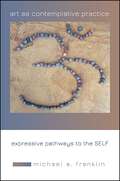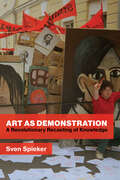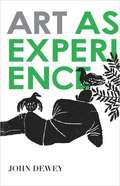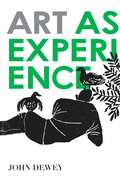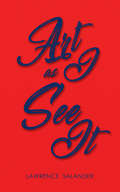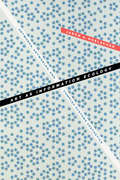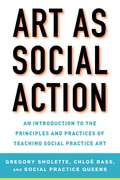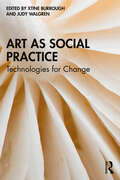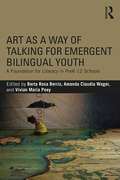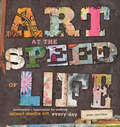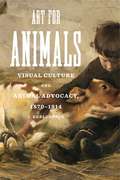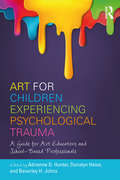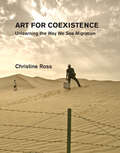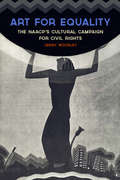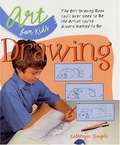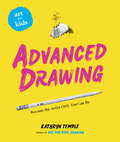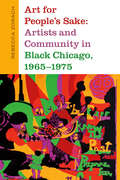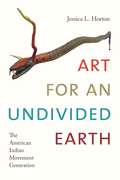- Table View
- List View
Art and the Religious Image in El Greco’s Italy
by Andrew R. CasperArt and the Religious Image in El Greco’s Italy is the first book-length examination of the early career of one of the early modern period’s most notoriously misunderstood figures. Born around 1541, Domenikos Theotokopoulos began his career as an icon painter on the island of Crete. He is best known, under the name “El Greco,” for the works he created while in Spain, paintings that have provoked both rapt admiration and scornful disapproval since his death in 1614. But the nearly ten years he spent in Venice and Rome, from 1567 to 1576, have remained underexplored until now. Andrew Casper’s examination of this period allows us to gain a proper understanding of El Greco’s entire career and reveals much about the tumultuous environment for religious painting after the Council of Trent.Art and the Religious Image in El Greco’s Italy is a new book in the Art History Publication Initiative (AHPI), a collaborative grant from the Andrew W. Mellon Foundation. Thanks to the AHPI grant, this book will be available in popular e-book formats.
Art and the Religious Image in El Greco’s Italy
by Andrew R. CasperArt and the Religious Image in El Greco’s Italy is the first book-length examination of the early career of one of the early modern period’s most notoriously misunderstood figures. Born around 1541, Domenikos Theotokopoulos began his career as an icon painter on the island of Crete. He is best known, under the name “El Greco,” for the works he created while in Spain, paintings that have provoked both rapt admiration and scornful disapproval since his death in 1614. But the nearly ten years he spent in Venice and Rome, from 1567 to 1576, have remained underexplored until now. Andrew Casper’s examination of this period allows us to gain a proper understanding of El Greco’s entire career and reveals much about the tumultuous environment for religious painting after the Council of Trent.Art and the Religious Image in El Greco’s Italy is a new book in the Art History Publication Initiative (AHPI), a collaborative grant from the Andrew W. Mellon Foundation. Thanks to the AHPI grant, this book will be available in popular e-book formats.
Art as Contemplative Practice: Expressive Pathways to the Self
by Michael A. FranklinDrawing upon his personal experience as a practitioner-researcher, visual artist, and cancer survivor, Michael A. Franklin offers a rich and thought-provoking guide to art as contemplative practice. His firsthand experience and original artwork complement this extensive discussion by consulting various practice traditions including yoga, rasa and darshan experiences, imaginal intelligence, and the contemplative instincts of select early twentieth-century artists. From this synthesis, Franklin suggests that we treat art as a form of yoga and meditation with the potential to awaken deeper insight into the fundamental nature of the Self. Exercises and rubrics are included that offer accessible instruction for any artist, meditation or yoga practitioner, art educator, or art therapist.
Art as Culture: An Introduction to the Anthropology of Art
by Evelyn Payne Hatcheran introduction of art as it relates to anthropology
Art as Demonstration: A Revolutionary Recasting of Knowledge
by Sven SpiekerHow artists wield demonstration to question the status quo both aesthetically and politically, marshaling art and education as powerful agents of change.Demonstration, in short, says: See here. It is the practice of pointing to something in order to explain or contest it. As such, Sven Spieker argues that demonstration has helped reshape art from the height of the Cold War to the late twentieth century, reformatting our understanding of how art and political engagement relate to each other. Focusing on Western Europe (especially Germany), Eastern Europe, and the United States, Art as Demonstration expands on contemporary discussions of art-as-protest, activism, and resistance. Spieker shows how a closer, more historical look at art&’s connection with demonstration reconnects us with earlier efforts, notably by the early twentieth-century avant-garde, to marshal art for the purpose of instruction and engagement.Art as Demonstration reconceives the history of postwar art in Eastern and Western Europe from the perspective of demonstration, understood formally (as a technique for showing and pointing) as well as politically (as protest, resistance, etc.). Close analyses of individual artworks reveal how the deployment of demonstration has changed over time. Spieker shows how &“protest&” and &“resistance&” organize art and artists not only politically but also and especially formally and aesthetically—a development of particular importance in the Cold War art and politics of Eastern Europe. The book illustrates how from the 1960s onward demonstration radically changed the way artists thought about art: no longer as an object but as a form of education.
Art as Experience
by John DeweyBased on John Dewey's lectures on esthetics, delivered as the first William James Lecturer at Harvard in 1932, Art as Experience has grown to be considered internationally as the most distinguished work ever written by an American on the formal structure and characteristic effects of all the arts: architecture, sculpture, painting, music, and literature.
Art as Experience
by John DeweyBased on John Dewey's lectures on esthetics, delivered as the first William James Lecturer at Harvard in 1932, Art as Experience has grown to be considered internationally as the most distinguished work ever written by an American on the formal structure and characteristic effects of all the arts: architecture, sculpture, painting, music, and literature.
Art as I See It
by Lawrence SalanderA working painter for over 50 years, and owner and director of the internationally renowned Salander-O'Reilly Galleries in New York City, where he was responsible for presenting over 600 museum quality exhibitions of art to the public, Salander is in a unique position to have a deep insight of all aspects of art and its making. This is an extremely personal book, and it is evident that Salander is both passionate and knowledgeable about his subject.
Art as Information Ecology: Artworks, Artworlds, and Complex Systems Aesthetics (Thought in the Act)
by Jason A. HoelscherIn Art as Information Ecology, Jason A. Hoelscher offers not only an information theory of art but an aesthetic theory of information. Applying close readings of the information theories of Claude Shannon and Gilbert Simondon to 1960s American art, Hoelscher proposes that art is information in its aesthetic or indeterminate mode—information oriented less toward answers and resolvability than toward questions, irresolvability, and sustained difference. These irresolvable differences, Hoelscher demonstrates, fuel the richness of aesthetic experience by which viewers glean new information and insight from each encounter with an artwork. In this way, art constitutes information that remains in formation---a difference that makes a difference that keeps on differencing. Considering the works of Frank Stella, Robert Morris, Adrian Piper, the Drop City commune, Eva Hesse, and others, Hoelscher finds that art exists within an information ecology of complex feedback between artwork and artworld that is driven by the unfolding of difference. By charting how information in its aesthetic mode can exist beyond today's strictly quantifiable and monetizable forms, Hoelscher reconceives our understanding of how artworks work and how information operates.
Art as Social Action: An Introduction to the Principles and Practices of Teaching Social Practice Art
by Gregory Sholette Chloë Bass Social Practice Queens"Art as Social Action . . . is an essential guide to deepening social art practices and teaching them to students." —Laura Raicovich, president and executive director, Queens MuseumArt as Social Action is both a general introduction to and an illustrated, practical textbook for the field of social practice, an art medium that has been gaining popularity in the public sphere. With content arranged thematically around such topics as direct action, alternative organizing, urban imaginaries, anti-bias work, and collective learning, among others, Art as Social Action is a comprehensive manual for teachers about how to teach art as social practice. Along with a series of introductions by leading social practice artists in the field, valuable lesson plans offer examples of pedagogical projects for instructors at both college and high school levels with contributions written by prominent social practice artists, teachers, and thinkers, including: Mary Jane Jacob Maureen Connor Brian Rosa Pablo Helguera Jen de los Reyes Jeanne van Heeswick Jaishri Abichandani Loraine Leeson Ala Plastica Daniel Tucker Fiona Whelan Bo Zheng Dipti Desai Noah Fischer Lesson plans also reflect the ongoing pedagogical and art action work of Social Practice Queens (SPQ), a unique partnership between Queens College CUNY and the Queens Museum.
Art as Social Practice: Technologies for Change
by Xtine Burrough Judy WalgrenWith a focus on socially engaged art practices in the twenty-first century, this book explores how artists use their creative practices to raise consciousness, form communities, create change, and bring forth social impact through new technologies and digital practices. Suzanne Lacy’s Foreword and section introduction authors Anne Balsamo, Harrell Fletcher, Natalie Loveless, Karen Moss, and Stephanie Rothenberg present twenty-five in-depth case studies by established and emerging contemporary artists including Kim Abeles, Christopher Blay, Joseph DeLappe, Mary Beth Heffernan, Chris Johnson, Rebekah Modrak, Praba Pilar, Tabita Rezaire, Sylvain Souklaye, and collaborators Victoria Vesna and Siddharth Ramakrishnan. Artists offer firsthand insight into how they activate methods used in socially engaged art projects from the twentieth century and incorporated new technologies to create twenty-first century, socially engaged, digital art practices. Works highlighted in this book span collaborative image-making, immersive experiences, telematic art, time machines, artificial intelligence, and physical computing. These reflective case studies reveal how the artists collaborate with participants and communities, and have found ways to expand, transform, reimagine, and create new platforms for meaningful exchange in both physical and virtual spaces. An invaluable resource for students and scholars of art, technology, and new media, as well as artists interested in exploring these intersections.
Art as a Way of Talking for Emergent Bilingual Youth: A Foundation for Literacy in PreK-12 Schools
by Berta Rosa Berriz Amanda Claudia Wager Vivian Maria PoeyThis book features effective artistic practices to improve literacy and language skills for emergent bilinguals in PreK-12 schools. Including insights from key voices from the field, this book highlights how artistic practices can increase proficiency in emergent language learners and students with limited access to academic English. Challenging current prescriptions for teaching English to language learners, the arts-integrated framework in this book is grounded in a sense of student and teacher agency and offers key pedagogical tools to build upon students’ sociocultural knowledge and improve language competence and confidence. Offering rich and diverse examples of using the arts as a way of talking, this volume invites teacher educators, teachers, artists, and researchers to reconsider how to fully engage students in their own learning and best use the resources within their own multilingual educational settings and communities.
Art at the Speed of Life: motivation + inspiration for making mixed-media art every day
by Pam CarrikerOffering terrific mixed-media art projects, as well as great tips for getting organized and inspired, Art at the Speed of Life is a treasure chest of ideas for the artist whose fiery enthusiasm for creating art goes up in smoke after that frantic pace of a long day. Author and mixed-media artist Pam Carriker will prove to you that art and life can co-exist productively and happily, while making daily creative outlets a reality and not just wishful thinking.Each chapter in Art at the Speed of Life includes both essays and project ideas from a variety of contributors, including Suzi Blu, Lisa Bebi, Christy Hydeck, Paulette Insall, Cate Calacous Prato. It all begins with prepatory advice on how to manage your supplies and physically make space for you to work. This is followed by more than 15 projects that are inspiring, yet easy to complete on even the tightest of schedules and includes fun techniques such as assemblages, image transfers, and collages that are sure to keep you motivated. Plus, a bonus seven-day project journal helps you track your work as you go. Offering a unique combination of realistic time-management tips, inspiring essays, and easy-to-fit-in projects, Art at the Speed of Life will help you realize your dream of making art every day easily and happily.
Art before the Law
by Ruth RonenEver since Plato expelled the poets from his ideal state, the ethics of art has had to confront philosophy's denial of art's morality. In Art before the Law, Ruth Ronen proposes a new outlook on the ethics of art by arguing that art insists on this tradition of denial, affirming its singular ethics through negativity.Ronen treats the mechanism of negation as the basis for the relationship between art and ethics. She shows how, through moves of denial, resistance, and denouncement, art exploits its negative relation to morality. While deception, fiction, and transgression allegedly locate art outside morality and ethics, Ronen argues they enable art to reveal the significance of the moral law, its origins, and the idea of the good. By employing the thought of Freud and Lacan, Ronen reconsiders the aesthetic tradition from Plato through Kant and later philosophers of art in order to establish an ethics of art. An interdisciplinary study, Art before the Law is sure to be of interest both to academic philosophers and to those interested in psychoanalytic theory and practice.
Art beyond Itself: Anthropology for a Society without a Story Line
by David Frye Néstor García CancliniFirst published in Spanish in 2010, Art beyond Itself is Néstor García Canclini's deft assessment of contemporary art. The renowned cultural critic suggests that, ideally, art is the place of imminence, the place where we glimpse something just about to happen. Yet, as he demonstrates, defining contemporary art and its role in society is an ever more complicated endeavor. Museums, auction houses, artists, and major actors in economics, politics, and the media are increasingly chummy and interdependent. Art is expanding into urban development and the design and tourism industries. Art practices based on objects are displaced by practices based on contexts. Aesthetic distinctions dissolve as artworks are inserted into the media, urban spaces, digital networks, and social forums. Oppositional artists are adrift in a society without a clear story line. What, after all, counts as transgression in a world of diverse and fragmentary narratives? Seeking a new analytic framework for understanding contemporary art, García Canclini is attentive to particular artworks; to artists including Francis Alÿs, León Ferrari, Teresa Margolles, Antoni Muntadas, and Gabriel Orozco; and to efforts to preserve, for art and artists, some degree of independence from religion, politics, the media, and the market.
Art for Animals: Visual Culture and Animal Advocacy, 1870–1914 (Animalibus)
by J. Keri CroninAnimal rights activists today regularly use visual imagery in their efforts to shape the public’s understanding of what it means to be “kind,” “cruel,” and “inhumane” toward animals. Art for Animals explores the early history of this form of advocacy through the images and the people who harnessed their power.Following in the footsteps of earlier-formed organizations like the RSPCA and ASPCA, animal advocacy groups such as the Victoria Street Society for the Protection of Animals from Vivisection made significant use of visual art in literature and campaign materials. But, enabled by new and improved technologies and techniques, they took the imagery much further than their predecessors did, turning toward vivid, pointed, and at times graphic depictions of human-animal interactions. Keri Cronin explains why the activist community embraced this approach, details how the use of such tools played a critical role in educational and reform movements in the United States, Canada, and England, and traces their impact in public and private spaces. Far from being peripheral illustrations of points articulated in written texts or argued in impassioned speeches, these photographs, prints, paintings, exhibitions, “magic lantern” slides, and films were key components of animal advocacy at the time, both educating the general public and creating a sense of shared identity among the reformers.Uniquely focused on imagery from the early days of the animal rights movement and filled with striking visuals, Art for Animals sheds new light on the history and development of modern animal advocacy.
Art for Animals: Visual Culture and Animal Advocacy, 1870–1914 (Animalibus: Of Animals and Cultures #12)
by J. Keri CroninAnimal rights activists today regularly use visual imagery in their efforts to shape the public’s understanding of what it means to be “kind,” “cruel,” and “inhumane” toward animals. Art for Animals explores the early history of this form of advocacy through the images and the people who harnessed their power.Following in the footsteps of earlier-formed organizations like the RSPCA and ASPCA, animal advocacy groups such as the Victoria Street Society for the Protection of Animals from Vivisection made significant use of visual art in literature and campaign materials. But, enabled by new and improved technologies and techniques, they took the imagery much further than their predecessors did, turning toward vivid, pointed, and at times graphic depictions of human-animal interactions. Keri Cronin explains why the activist community embraced this approach, details how the use of such tools played a critical role in educational and reform movements in the United States, Canada, and England, and traces their impact in public and private spaces. Far from being peripheral illustrations of points articulated in written texts or argued in impassioned speeches, these photographs, prints, paintings, exhibitions, “magic lantern” slides, and films were key components of animal advocacy at the time, both educating the general public and creating a sense of shared identity among the reformers.Uniquely focused on imagery from the early days of the animal rights movement and filled with striking visuals, Art for Animals sheds new light on the history and development of modern animal advocacy.
Art for Children Experiencing Psychological Trauma: A Guide for Art Educators and School-Based Professionals
by Beverley H. Johns Adrienne D. Hunter Donalyn HeiseArt for Children Experiencing Psychological Trauma aims to increase understanding of art’s potential to enhance learning for children living in crisis. In this ground-breaking resource, the first of its kind to focus specifically on the connection between art education and psychological trauma in youth populations, readers can find resources and practical strategies for both teachers and other school-based professionals. Also included are successful models of art education for diverse populations, with specific attention to youth who face emotional, mental, behavioral, and physical challenges, as well a framework for meaningful visual arts education for at-risk/in-crisis populations.
Art for Coexistence: Unlearning the Way We See Migration
by Christine RossAn exploration of how contemporary art reframes and humanizes migration, calling for coexistence—the recognition of the interdependence of beings.In Art for Coexistence, art historian Christine Ross examines contemporary art&’s response to migration, showing that art invites us to abandon our preconceptions about the current &“crisis&”—to unlearn them—and to see migration more critically, more disobediently. We (viewers in Europe and North America) must come to see migration in terms of coexistence: the interdependence of beings. The artworks explored by Ross reveal, contest, rethink, delink, and relink more reciprocally the interdependencies shaping migration today—connecting citizens-on-the-move from some of the poorest countries and acknowledged citizens of some of the wealthiest countries and democracies worldwide. These installations, videos, virtual reality works, webcasts, sculptures, graffiti, paintings, photographs, and a rescue boat, by artists including Banksy, Ai Weiwei, Alejandro González Iñárritu, Laura Waddington, Tania Bruguera, and others, demonstrate art&’s power to mediate experiences of migration. Ross argues that art invents a set of interconnected calls for more mutual forms of coexistence: to historicize, to become responsible, to empathize, and to story-tell. Art history, Ross tells us, must discard the legacy of imperialist museology—which dissocializes, dehistoricizes, and depoliticizes art. It must reinvent itself, engaging with political philosophy, postcolonial, decolonial, Black, and Indigenous studies, and critical refugee and migrant studies.
Art for Equality: The NAACP's Cultural Campaign for Civil Rights (Civil Rights and the Struggle for Black Equality in the Twentieth Century)
by Jenny WoodleyA study of the NAACP’s activism in the cultural realm through creative projects from 1910 to the 1960s.The National Association for the Advancement of Colored People (NAACP) is the nation’s oldest civil rights organization, having dedicated itself to the fight for racial equality since 1909. While the group helped achieve substantial victories in the courtroom, the struggle for civil rights extended beyond gaining political support. It also required changing social attitudes. The NAACP thus worked to alter existing prejudices through the production of art that countered racist depictions of African Americans, focusing its efforts not only on changing the attitudes of the White middle class but also on encouraging racial pride and a sense of identity in the Black community.Art for Equality explores an important and little-studied side of the NAACP’s activism in the cultural realm. In openly supporting African American artists, writers, and musicians in their creative endeavors, the organization aimed to change the way the public viewed the Black community. By overcoming stereotypes and the belief of the majority that African Americans were physically, intellectually, and morally inferior to Whites, the NAACP believed it could begin to defeat racism.Illuminating important protests, from the fight against the 1915 film The Birth of a Nation to the production of anti-lynching art during the Harlem Renaissance, this insightful volume examines the successes and failures of the NAACP’s cultural campaign from 1910 to the 1960s. Exploring the roles of gender and class in shaping the association's patronage of the arts, Art for Equality offers an in-depth analysis of the social and cultural climate during a time of radical change in America.Praise for Art for Equality“A well-conceived and well-executed study that will add significantly to the historiography of the NAACP, the long civil rights movement, and African American history.” —John Kirk, George W. Donaghey Professor and Chair of the History Department at the University of Arkansas at Little Rock“In this insightful book, Woodley writes with great verve and confidence. As a result, Art for Equality will attract readers in a variety of fields from African American history to art history to American political history.” —Matthew Pratt Guterl, Brown University“A necessary contribution to African American social and cultural histories.” —Journal of Southern History
Art for Kids Drawing
by Kathryn TempleWith the help of lots of exercises, budding artists will learn the basic elements of shapes (lines, dots, circles) and see how to combine them to make familiar forms. They'll find out how to produce the illusion of volume with shading techniques; create perspective; accurately recreate landscapes, people, animals, and nature; develop interesting compositions; and more.
Art for Kids: Become the Artist Only You Can Be (Art for Kids)
by Kathryn Temple&“This is a gold mine of information for any kid that doodles.&”—Library Media Connection This companion volume to Art for Kids: Drawing builds on skills taught in the first book, focusing on the integrating and big picture skills of drawing and the creative process. These include style, composition, content selection, sources of inspiration, quality of line (loose and gestural vs. clean and tight), as well as grounding and contextualizing subjects. Filled with clear instructions, easy-to-use techniques, and a wealth of encouragement, get ready to make great original drawings. You&’ll be amazed by the art they can create!
Art for People's Sake: Artists and Community in Black Chicago, 1965-1975
by Rebecca ZorachIn the 1960s and early 1970s, Chicago witnessed a remarkable flourishing of visual arts associated with the Black Arts Movement. From the painting of murals as a way to reclaim public space and the establishment of independent community art centers to the work of the AFRICOBRA collective and Black filmmakers, artists on Chicago's South and West Sides built a vision of art as service to the people. In Art for People's Sake Rebecca Zorach traces the little-told story of the visual arts of the Black Arts Movement in Chicago, showing how artistic innovations responded to decades of racist urban planning that left Black neighborhoods sites of economic depression, infrastructural decay, and violence. Working with community leaders, children, activists, gang members, and everyday people, artists developed a way of using art to help empower and represent themselves. Showcasing the depth and sophistication of the visual arts in Chicago at this time, Zorach demonstrates the crucial role of aesthetics and artistic practice in the mobilization of Black radical politics during the Black Power era.
Art for an Undivided Earth: The American Indian Movement Generation
by Jessica L. HortonIn Art for an Undivided Earth Jessica L. Horton reveals how the spatial philosophies underlying the American Indian Movement (AIM) were refigured by a generation of artists searching for new places to stand. Upending the assumption that Jimmie Durham, James Luna, Kay WalkingStick, Robert Houle, and others were primarily concerned with identity politics, she joins them in remapping the coordinates of a widely shared yet deeply contested modernity that is defined in great part by the colonization of the Americas. She follows their installations, performances, and paintings across the ocean and back in time, as they retrace the paths of Native diplomats, scholars, performers, and objects in Europe after 1492. Along the way, Horton intervenes in a range of theories about global modernisms, Native American sovereignty, racial difference, archival logic, artistic itinerancy, and new materialisms. Writing in creative dialogue with contemporary artists, she builds a picture of a spatially, temporally, and materially interconnected world—an undivided earth.

